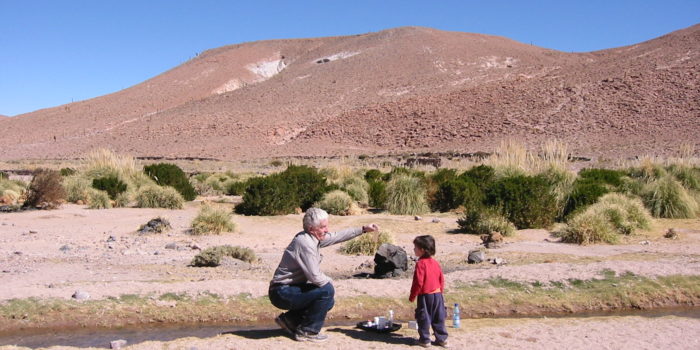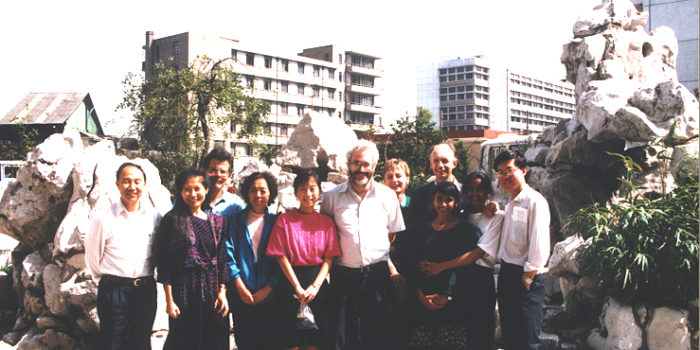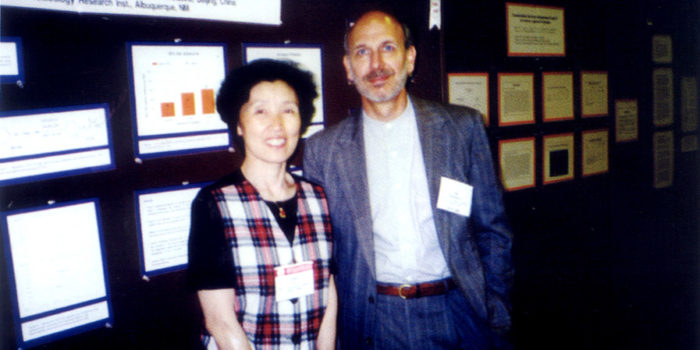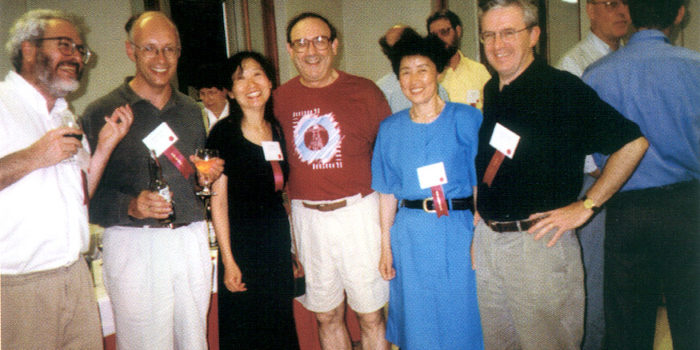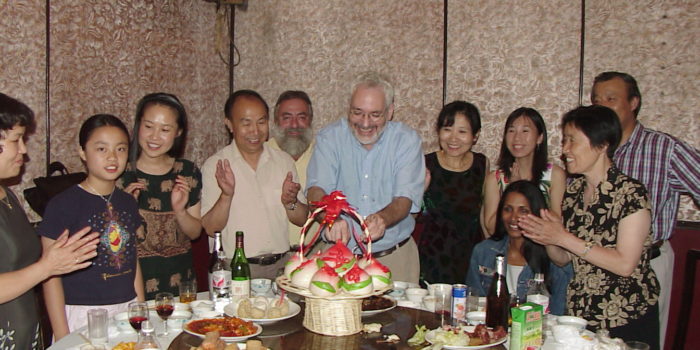30 Years and Counting – History of the UC Berkeley Superfund Research Center
Beginnings
In 1986, the NIEHS Hazardous Substances Basic Research and Training Program [the Superfund Basic Research Program (SBRP)] was created under the Superfund Amendments and Reauthorization Act (SARA). Congress, under SARA, authorized the National Institute of Environmental Health Sciences (NIEHS) to develop a university-based program of basic research and training grants to address the wide array of scientific uncertainties facing the national Superfund Program. Our program at UC Berkeley along with investigators at UCSF was one of the first 4 Centers to be funded by NIEHS under the SBRP in 1987. The Berkeley Center is the only Center to be continuously funded since 1987.
In the early days of the Center, Eastmond, Irons and Smith (1987) reported that benzene’s phenolic metabolites caused synergistic bone marrow toxicity, leading to a mechanistic hypothesis for benzene’s carcinogenicity that has stood the test of time. Stephen Rappaport developed a method of measuring protein adducts from styrene oxide and other electrophilic metabolites and later invented adductomics and exposomics, measuring a wide array of chemicals bound to blood proteins. John Wiencke at UCSF found a strong correlation between genetic enzymatic deficiencies and induction of sister chromatid exchange. Also at UCSF, William Bodell used 32P-postlabeling to identify DNA adducts and, with Al Burlingame, identified adducts formed from exposure to styrene and benzoquinone, a toxic metabolite of benzene. In modeling and pharmacokinetic research, Robert Spear developed a physiologically-based pharmacokinetic model of benzene metabolism and Thomas Tozer at UCSF developed a pharmacokinetic model for perchloroethylene.
Engineering projects were added to the Program in 1988 to create a multi-disciplinary Center. Shortly after, James Hunt and Kent Udell demonstrated that steam injection effectively removed polluting solvents from soils at hazardous waste sites. Joan Daisey of LBNL was successful in modeling the migration of pollutants from soil gas carrying pollutants into homes. This was the first demonstration of so-called ‘vapor intrusion’ of chemicals into homes near Superfund sites. John Harte and Susan Anderson developed a battery of genotoxicity tests using three aquatic species. Catherine Koshland and Robert Sawyer identified toxic byproduct production in combustion and waste incineration, showing that at sub-optimal temperatures relatively innocuous compounds such as ethyl chloride could be converted into highly hazardous chemicals, such as vinyl chloride.
Post 1992 leads to the addition of epidemiology and steam injection comes to real-world fruition
In the 1992 renewal, we added epidemiology to the Center’s portfolio. Allan Smith’s studies in Nevada and Chile uncovered a high incidence in bladder cancers from arsenic exposure. His paper on arsenic cancer risk cited over a 1000 times. Using a novel micronucleus assay developed by Nina Holland, we were the first to demonstrate that concentrations of arsenic in drinking water at the US standard of 50 ppb produced increased levels of genetic damage in bladder epithelial cells of humans who drank the water. Using accelerator mass spectrometry Ken Turteltaub of LLNL detected DNA adduct formation in bone marrow and liver following exposure to very low doses of benzene and trichloroethylene. During this period Lisa Alvarez-Cohen joined the Center studying trichloroethylene biodegradation and Kent Udell completed a full-scale demonstration of steam injection for contaminant removal at a hazardous waste site. This technology eventually led to the first ever complete clean-up of a Superfund site in Visalia, CA. Simultaneously, Catherine Koshland developed an in situ real time technique for detecting and monitoring chemicals in waste incinerators.
1995 sees the field of Childrens’ Environmental Health blossom
In the 1995 renewal, two new epidemiological studies were added. Patricia Buffler, was funded to conduct her first study of childhood leukemia by the SRP, which eventually led to the Center for Integrative Research on Childhood Leukemia and the Environment (CIRCLE) for the study of causes of leukemia in children, now led by Catherine Metayer. The second epidemiological study targeted reproductive health and was led by Brenda Eskenazi and Andrew Wyrobek of LLNL. The 1995 reauthorization also brought the addition of an Outreach Core called the Children’s Environmental Health Network (CEHN). Headed by Joy Carlson, CEHN promoted awareness and trained health professionals to recognize and treat environmental health problems in children. It has had a major impact on promoting the Childrens’ environmental health at the national level and led to the funding of Childrens’ Environmental Health Centers by NIEHS and the EPA. There are 3 of these Centers at Berkeley: CERCH, a Center of Excellence in Children’s Environmental Health led by Brenda Eskenazi that funds the Center for the Health Assessment of Mothers and Children of Salinas (CHAMACOS) study, CIRCLE and CHAPS, the Children’s Health and Air Pollution Study, led by Katharine Hammond and John Balmes. A study of the effects of air pollution and stress in children living in Richmond has also recently been funded by the Koret Foundation and involves SRP researchers Martyn Smith and Rachel Morello-Frosch with Katherine Hammond, John Balmes and Neeta Thakur of UCSF.
2000 Onwards
After the 2000 renewal of the Center, our research on benzene bears more fruit. In a publication in Science in 2004, Smith, Rappaport and Zhang working with NCI and Chinese investigators showed that benzene was hematotoxic at low levels of occupational exposure as a result of stem and progenitor cell injury and that certain people were genetically susceptible to its effects. Subsequently, Rappaport et al found a supra-linear (greater-than-proportional) production of toxic metabolites and benzene-related protein adducts at air concentrations below 1 ppm allowing us to conclude that true leukemia risks from benzene could be substantially greater than currently thought at ambient levels of exposure. This motivated the US EPA to take action to reduce cancer risks from mobile sources (Control of Hazardous Air Pollutants From Mobile Sources), by lowering the benzene content of gasoline to 0.62% in 2011, extensively citing our research in justifying their decision.
On the engineering side, Lisa Alvarez-Cohen and her research team made the first successful attempt to use stable isotopes to demonstrate the complete in situ biodegradation of chlorinated solvents by enhanced bioremediation. Isotope measurements allowed the tracking and control of the potential generation of harmful biological intermediates. This success resulted in a cost savings of approximately $15 million for the cleanup of a field site.
Also in this period, Joe Wiemels (now at UCSF), Cliona McHale working with Buffler, Wiencke, Zhang and Smith show that most childhood leukemias begin before birth and are associated with parental chemical exposures. This work continues in CIRCLE.
Renewed again in 2005
Successes in this period include Allan Smith being the first to identify an association between early life arsenic exposure and adult mortality and he begins the Arsenic Health Effects Research Program.
For his Ph.D. Marty Mulvihill works with Peidong Yang to development a patented method for arsenic detection using nanotechnology and becomes Associate Director of the Berkeley Center for Green Chemistry (https://bcgc.berkeley.edu/)
In engineering science, Alvarez-Cohen and her research team develop a rapid test to determine the effectiveness of bioremediation enzymes.
Sponsorship of the Flame Retardant Dilemna
Beginning in 2007, our UC Berkeley Superfund Center sponsored a series of on-campus meetings called the ‘Flame Retardant Dilemna’. These meetings promoted the issue of excessive flame retardant use, which was being questioned by Arlene Blum and others. Arlene founds the Green Science Policy Institute and continues these meetings, having teamed up with long time SRP researcher Donald Lucas. The 2018 meeting is on February 9, 2018 in 150 University Hall on the Berkeley campus.
2010 Onwards
In arsenic research, Allan Smith and Craig Steinmaus provide the first human evidence of a major synergy between obesity and a common chemical contaminant at increasing cancer risk. These investigators have shown that arsenic in drinking water poses higher risks of fatal disease than any other environmental chemical exposure. Xuefeng Ren in Smith/Zhang lab discovered that a protein called N6AMT1 (N-6 adenine-specific DNA methyltransferase 1) can metabolize arsenic compounds and lower their toxicity.
David Sedlak’s team made great progress in water treatment as they develop a compact and inexpensive water treatment system that has the potential to be employed for wellhead treatment or point-of-use treatment in situations where water is contaminated with organic chemicals. The system has numerous advantages over existing approaches because it can be operated without the need to replenish reagents or replace materials (e.g., as is the case with activated carbon).
SRP trainees Jay James and Jeffrey Crosby under, the guidance of Catherine Koshland and Donald Lucas, demonstrated the utility of gold nanoparticles as the basis of a patented stand-alone, inexpensive, and sensitive mercury sensor for environmental monitoring. This technology won first place in the energy and cleantech category at the 2014 UC Berkeley Startup Competition April 24. This led to James and Crosby founding the company Picoyune to provide accurate and reliable mercury monitoring for industrial and environmental applications. This provides an excellent example of how research in a SRP Center can lead to patented technologies and small business innovation.
Christopher Vulpe, Luoping Zhang and coworkers use yeast, haploid human cells and now CRISPR-based screens to study genetic susceptibility to environmental chemicals. Zhang and Vulpe spoke recently (January 10, 2018) and an NAS meeting on using CRISPR to advance risk assessment and environmental health research.
In 2010, Stephen Rappaport and Martyn Smith develop the idea of measuring the exposome by analyzing snapshots of the internal chemical environment. Rappaport organized two National Academy meetings on this topic in 2010 and 2011 and Smith spoke at the European Union in Brussels in 2011 leading to EU funding of exposomics projects. Rappaport and Smith published a paper in Science in 2010, which concluded that the exposome could best be measured by monitoring the internal chemical environment of the human body during critical windows of exposure.
The potential for using the exposome concept to study cumulative impacts and mixtures arose out of a “Seeing the Whole Picture” meeting that Amy Kyle of our Research Translation Core organized in 2013. This forms the basis of the current proposal and the concept of the exposome continues to gain traction. Amy also produced the “Science for a Safer World” and the multiple investigator and trainee videos that are now featured prominently on our website (https://superfund.berkeley.edu).
Current Program renewed in 2017 for 5 years
The overall theme of the current UC Berkeley Superfund Research Center is the ‘Exposome’ and our overall goal will be to begin to move forward the field of exposomics to address the issue of cumulative risk and other issues facing the SRP’s main stakeholders. The EPA defines cumulative risk as, “Combined risks from aggregate exposures to multiple agents or stressors, where agents or stressors may include chemical and nonchemical stressors”. This is essentially the exposome paradigm where all non-genetic environmental stressors are considered as environmental exposures. Therefore, cumulative risk assessment, where the impact of all stressors on a population is assessed, could be operationalized by exposomics. Communities living near hazardous waste sites typically face cumulative risks from a variety of environmental and social factors. We propose a step-wise approach to applying exposomics to the complex problems found at Superfund sites.
The EPA, Agency for Toxic Substances and Disease Registry (ATSDR) and other agencies face a series of complex problems in remediating and assessing risks posed at Superfund and other hazardous waste sites. These complex problems include:
- The Problem of Cumulative Risks in Vulnerable Populations: Chemical exposures do not occur in isolation and commonly occur in combination and in conjunction with other interacting risk factors, such as smoking, obesity, low socioeconomic status and chronic psychosocial stress;
- The Problem of Assessing Risks from Past Exposures, Especially Early-life Exposures: Exposures have a temporal component and our research has shown that early-life exposures may have important long-term impacts – the exposome covers all life stages and may help in assessing risk from critical windows of exposure that may be in the distant past;
- The Problem of Mixtures: Hazardous waste sites typically contain multiple chemical contaminants and both remediation and health impact assessment must account for interactions between mixtures of chemicals;
- The Problem of Complexity: Chemical exposures operate through multiple unique and overlapping mechanisms/pathways that need to be clarified and accounted for. Metabolism within the body or transformation during the remediation process also results in toxic intermediates being formed that complicate risk assessment and effective remediation.
Our proposed research, translation and community engagement efforts aim to apply the exposome paradigm to provide information and tools that will help solve these four complex problems associated with assessing cumulative risk from multiple environmental stressors, past exposures and chemical mixtures (Figure 1).
We have also added, for the first time a Community Engagement Core (CEC) led by Rachel Morello-Frosch that will focus especially on access to clean drinking water in California and elsewhere.
Figure 1. How the 6 proposed projects and the Community Engagement Core (CEC) aim to address the four identified problems using an exposomics approach (*Project number)

Throughout many years of the Center, Alan Hubbard has led a biostatistics team that has provided invaluable service to Center researchers and has been highly innovative in their statistical approaches. Dr. Hubbard’s team developed data-adaptive methods for incorporating cutting-edge machine learning methods (e.g. SuperLearner) to determine which data processing streams generate a better signal to noise ratio. Their findings suggest 1) big differences in the relative merits of the possible processing choices and the ultimate quality of the data, and 2) that such machine-learning based methods can be practically applied to complex omic data from the projects.
Recent Trainees
These include Xuefeng Ren who was recently awarded tenure at the University at Buffalo – SUNY and Fenna Sille and Carsten Prasse, former postdocs in the Center, were recently appointed as Assistant Professors at the Johns Hopkins University.
Recent Successes in 2018
1) New ways to assess health risks from multiple environmental stressors
In an ongoing collaboration with monthly meetings, SRP investigators (McHale, Smith, Zhang, and Morello-Frosch) along with risk assessment practitioners at the California EPA and California Office of Environmental Health Hazard Assessment (OEHHA) developed a new concept to explain the effects of interactive and cumulative factors in disease risk. Going beyond a gene-by-environment (G×E) approach, our concept – called I×E (intrinsic by extrinsic) – incorporates the multi-factorial and dynamic nature of health and disease by integrating results from genomics, G×E, developmental origins of health and disease, and the exposome. We describe how I×E can be applied to research and risk assessment in our recently published paper https://www.sciencedirect.com/science/article/pii/S1383574217300698] [McHale et al., Assessing health risks from multiple environmental stressors: Moving from G×E to I×E. Mutation Research-Reviews in Mutation Research (2018) 775:11-20. NIHMS:929073, doi.org/10.1016/j.mrrev.2017.11.003.]
2) TCE contamination poses an endocrine-disrupting threat
In a paper just published in Environmental Science and Technology researchers in Project 2 report that trichloroethylene, TCE, the most common pollutant found at Superfund sites, and some of its metabolites may act as endocrine disruptors (http://pubs.acs.org/doi/10.1021/acs.est.7b04832). TCE has been reported to cause several toxic effects, but little effort has been made to assess the endocrinological risks of TCE or its major metabolites: trichloroethanol (TCOH), trichloroacetic acid, and oxalic acid (OA). SRP graduate student trainees Phum Tachachartvanich and Sylvia Sanchez examined alterations in the steroidogenesis pathway using the NCI-H295R cell line and utilized receptor-mediated luciferase reporter cell lines to identify effects of TCE and its metabolites on estrogen and androgen receptors. Molecular docking was also used to explore chemical interactions with these receptors. All test chemicals except OA significantly increased 17β-estradiol production which was attributed to an up-regulation of 17β-hydroxysteroid dehydrogenase in the exposed cells. Moreover, TCOH exhibited significant anti-estrogenic activity with a RIC20 (20% relative inhibitory concentration) of 3.7 × 10-7 M. Molecular docking simulation supported this finding with lower docking scores for TCOH, indicating that hydrogen bonds may stabilize the interaction between TCOH and the estrogen receptor binding pocket. These findings suggest that TCE contamination poses an endocrine-disrupting threat, which has implications for both ecological and human health.
3) An electrochemical treatment system to remove toxic metals from drinking water
As part of Project 5’s effort to develop an electrochemical treatment system, Sedlak’s team investigated the ability of the system to convert dissolved metals into forms that could be settled or filtered prior to drinking water consumption. In their paper just published in Environmental Science and Technology (Barazesh J.M., Prasse C., Wenk J., Berg S., Remucal C.K. and Sedlak D.L. (2018) Trace Element Removal in Distributed Drinking Water Treatment Systems by Cathodic H2O2 Production and UV Photolysis. Environ. Sci. Technol. 52,195–204), they report that both ultraviolet light and exposure to hydrogen peroxide rendered natural organic matter present in groundwater unable to form dissolved iron complexes. The electrochemical treatment system produced iron-containing precipitates that were large enough to undergo gravitational settling. When treatment was employed in contaminated groundwater, dissolved arsenic, lead and copper were adsorbed or co-precipitated with the iron oxides, thereby allowing the electrochemical treatment system to remove toxic metals from drinking water. This opens up new avenues for point-of-use and water treatment system removal of hazardous metals in our drinking water.
4) Application of the Key Characteristics in Hazard Identification and Risk Assessment
Together with the International Agency for Research on Cancer (IARC) we have promoted the Key Characteristics approach to incorporating mechanistic data into hazard identification and risk assessment. We presented jointly at a Colloquium on Systematic Review and Meta Analysis at NIEHS, Research Triangle Park, NC, on August 24, 2017 with the title: Applying the Key Characteristics Paradigm in Cancer Hazard Identification. We have also promoted to concept in Japan, jointly presenting at the Japanese National Institute of Environmental Sciences and the University of Tokyo. This was well received by Japanese officials and researchers. We have reported our experience in using the Key Characteristics approach in the IARC Monographs Programme and discussed its successful application and opportunities for expansion and improvement in an article that will shortly be published in Carcinogenesis with Martyn Smith as senior author (Guyton KZ, Rusyn I, Chiu WA, Corpet DE, van den Berg M, Ross MK, Christiani DC, Beland FA and Smith MT (2018). Application of the Key Characteristics of Carcinogens in Cancer Hazard Identification. Carcinogenesis, in press). At the urging of the National Academy of Sciences report on 21st Century Risk Assessment, we have organized a 2 day meeting with IARC and CalEPA to be held at Berkeley in March 2018 on applying the Key Characteristics approach to endocrine disruptors and reproductive toxicants. The application of the Key Characteristics approach arising out of the Smith et al (2016) paper in Env. Health Persp. (Jun;124(6): 713-721. PMCID: PMC4892922) is therefore having a major impact on the risk assessment field.
Acknowledgements
This work was funded by NIH grant P42004705 from the National Institute of Environmental Health Sciences. The support of William Suk, Michelle Heacock and others in the SRP Program is greatly appreciated. None of this would have been possible without the support of numerous UC Staff members but most especially Susan Neal who was the Center’s original administrator, William Brockett and Minerva Reyes who sadly both recently retired after many years of superb service to the Center. I am grateful to my many faculty colleagues and I sincerely apologize if I missed anyone. The members of my laboratory over the past 30 years also contributed enormously, especially Cliona McHale, Nina Holland, Janice Yager, Christine Skibola, Joseph Wiemels, David Eastmond, John Curry, Xuefeng Ren, Iris Wang, Weihong Guo, Zhiying Ji, Hua Shen, Mathew Forrest, Jenny Quintana, Frederic Bois, Lee Moore, Vangala Subramanyam, Prema Kolachana, Martha Sandy and so many more. You have all been so productive, it is hard for me to comprehend. Thank you all.
